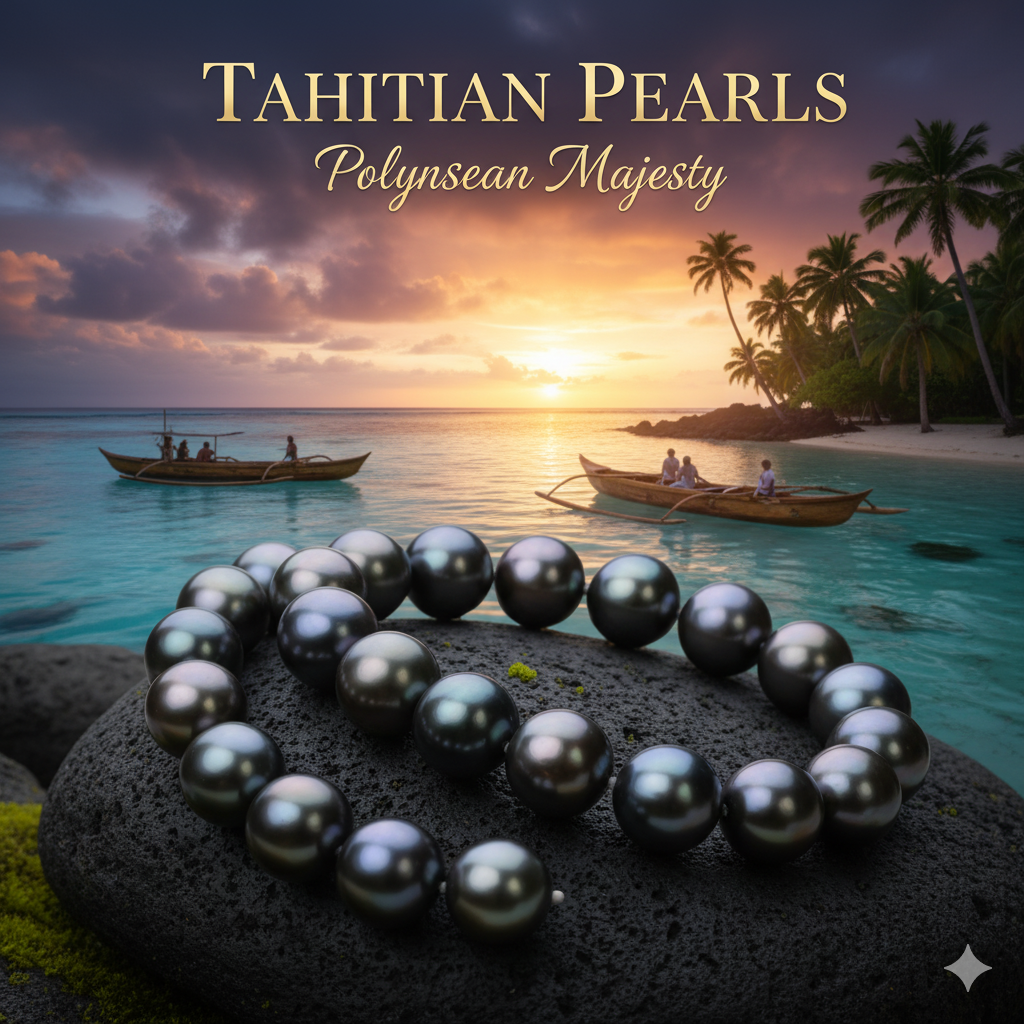Introduction
1) A Different Kind of Light
Every pearl is a mirror to its sea.
The Gulf yields pale silks, the South Sea gives golden dawns — but Tahitian pearls are the night sky itself.
They are not merely dark; they are luminous within darkness, carrying every hue a tropical dusk can imagine — green, aubergine, peacock, silver, and storm.
To hold one is to understand that black is not absence, but depth.
Among gem collectors, Tahitian pearls represent mystery made tangible. Among Polynesians, they are the tears of the gods, fallen into a quiet lagoon and hardened into grace.
2) Origins of the Black Pearl
Tahitian pearls are born in French Polynesia, scattered across the remote archipelagos of the South Pacific — Tuamotu, Gambier, and Marquesas.
Their mother oyster is the Pinctada margaritifera cumingii, the great black-lip pearl oyster.
Its shell shimmers with iridescent nacre — green, violet, and silver — and those same undertones become the soul of the pearls it forms.
The lagoons of Manihi, Ahe, Rangiroa, and Mangareva are the most famous.
Here, volcanic atolls form natural sanctuaries: warm, nutrient-rich, protected from open-ocean turbulence.
Water depth: 5–30 m.
Temperature: 26–30 °C.
Time required: 18–36 months of slow, immaculate creation.
Each oyster is seeded with a bead nucleus and a mantle graft from a donor of superior colour.
If nature cooperates, the nacre layers grow thick — sometimes over 2 mm — and when the oyster is finally lifted, the diver might find a sphere that seems to glow from its own shadow.
3) The Myth of Oro and the Rainbow
In Polynesian legend, Oro, the god of peace and fertility, descended to earth on a rainbow and offered the first black pearl to his beloved princess as a symbol of eternal devotion.
Ever since, the black pearl has been the jewel of reconciliation — light and darkness coexisting.
Local islanders still tell that story to new generations of pearl farmers, for it reminds them that no harvest is mechanical — each pearl is a prayer answered slowly.
4) A Brief History of Trade
Although natural black pearls were known to explorers in the 17th and 18th centuries, their rarity was legendary.
The Pinctada margaritifera could produce one naturally in perhaps one oyster out of many thousands.
In the 1960s, Jean-Marie Domard, a French researcher, perfected sustainable culturing techniques in the Tuamotu islands.
By 1975, Tahitian pearls had become a global fascination — exported through Papeete to Paris, Tokyo, and New York.
They were no longer curiosities but luxury symbols of the Pacific age.
Today, over 30 atolls cultivate them, yet true top-grade pieces remain rare — partly because grading standards in French Polynesia are strict, and partly because nature still refuses haste.
5) The Anatomy of Colour
To call Tahitian pearls “black” is a simplification. Their palette is vast.
| Primary Bodycolour | Common Overtones | Visual Effect |
|---|---|---|
| Charcoal Grey | Rose, Aubergine | Soft violet sheen |
| Green | Peacock (blue-green-rose blend) | Most coveted “peacock effect” |
| Silver | Blue, Green | Modern and cool |
| Copper | Bronze, Burgundy | Warm, exotic |
| Graphite Black | Steel, Aubergine | Masculine and architectural |
The peacock pearl — a seamless fusion of green, rose, and gold over a dark base — is considered the apex of Tahitian colour, commanding the highest prices.
6) Shape and Size
Typical sizes: 8–14 mm; exceptional specimens reach 17 or even 19 mm.
Shapes range from perfect rounds to drops, buttons, baroques, and circled pearls (bearing gentle natural rings around the body).
Baroques, once dismissed, are now celebrated for their sculptural individuality — the ocean’s handwriting on form.
7) The Luster of Depth
If South Sea pearls are dawn, Tahitians are twilight.
Their luster is neither mirror-bright nor subdued; it is metallic, almost liquid.
Light doesn’t merely bounce — it slides, tracing curves like mercury.
This visual phenomenon, often called “oriental metallic sheen,” is produced by tight aragonite layering within dark nacre — an effect impossible to fake through surface treatments.
Top-grade Tahitians possess luster so intense that you can glimpse your reflection blurred into colour.
8) Grading and Value
French Polynesia enforces a national quality code (introduced 1998).
Grades: A, B, C, D, E — based on surface, luster, and shape.
A-grade: High luster, minimal imperfections, symmetrical shape.
B-grade: Good luster, few blemishes.
C/D: Commercial quality.
Value drivers:
- Colour intensity and balance of overtones.
- Even surface and absence of pits.
- Shape (round > drop > baroque).
- Size (> 14 mm exponentially rarer).
- Luster depth.
A 16 mm peacock-green pearl of top grade can equal the price of a fine diamond.
9) Contrast with Other Pearls
| Type | Primary Origin | Colour Range | Mood |
|---|---|---|---|
| Akoya | Japan | White – rose silver | Classic moonlight |
| South Sea | Australia/Indonesia | White – gold | Regal sunrise |
| Tahitian | French Polynesia | Black – peacock – silver | Twilight luxury |
Tahitian pearls are the only naturally dark saltwater pearls in regular commercial production. Their allure lies in contrast: the marriage of shadow and iridescence.
10) Craft and Culture
Polynesian pearl farmers treat their lagoons as living cathedrals.
Oysters are suspended on ropes like choirs of shells; each morning, farmers dive to brush algae gently from them.
Harvest day feels ceremonial: boats glide in silence, baskets rise dripping with black shells, and when the first pearl surfaces, it’s shown to the sky before it’s shown to people.
This ritual respect defines the industry — a balance between livelihood and reverence.
11) Design and Modern Luxury
Designers adore Tahitian pearls for their drama.
- Single Statement Drops — one peacock pearl on a fine gold chain.
- Contrast Necklaces — dark Tahitian interwoven with white South Sea pearls.
- Men’s Jewelry — cufflinks, rings, and talismans using graphite-toned baroques.
Their dark iridescence pairs effortlessly with platinum, titanium, and rose gold — metals that echo the ocean’s metallic light.
12) Emotional Symbolism
Tahitian pearls are pearls of power.
They are worn not for delicacy but for presence.
In Polynesian myth, they bring fertility, wisdom, and protection during voyages.
In modern life, they speak of confidence without ostentation — the assurance that mystery itself is beautiful.
When light hits a Tahitian pearl, it doesn’t reveal; it invites.
That is its secret.
13) Sustainability and Sea Stewardship
Like all ethical pearl farms, Tahitian operations depend on pure water.
Hence, protecting lagoons is not marketing — it is survival.
Farmers enforce strict bans on industrial runoff and over-harvesting.
Oysters filter 40–50 gallons of water daily, improving lagoon health and sustaining fish populations.
Pearl farming here is one of the Pacific’s few industries where profit and ecology coincide.
14) Caring for Tahitian Pearls
- Wear often; skin contact maintains luster.
- Keep away from acids and perfumes.
- Wipe with a soft damp cloth after wear.
- Store flat and cool, not airtight.
- Re-string yearly if necklace.
Their surface may appear resilient, but the luster is tender — like a shadow that disappears under harsh light.
15) The Collector’s Perspective
Fine Tahitian pearls from early Gambier harvests or rare peacock hues are now museum pieces.
Collectors value them not merely for rarity but for emotional gravity — how the dark hue enhances calm and confidence.
Vintage French Polynesian strands, with slight tonal variation, are especially sought after because uniform perfection has become too industrial; collectors crave authentic variance — the rhythm of the lagoon itself.
16) The Market Today
Global demand continues steady at the high-luxury segment.
Japan remains the largest buyer; the US, Europe, and China follow.
Average wholesale prices range from USD 300–3,000 per pearl, exceptional lots exceeding USD 10,000.
Authentic certification from GIA, SSEF, or Laboratoire de Perles de Tahiti is standard practice for investment-grade strands.
17) Checklist for Buyers
✅ Origin — French Polynesia
✅ Species — Pinctada margaritifera cumingii
✅ Colours — Black, Green, Peacock, Silver, Aubergine
✅ Size — 8–17 mm (common)
✅ Luster — Metallic, high orient
✅ Shape — Round / Drop / Baroque
✅ Certification — GIA / SSEF / LDP Tahiti
✅ Care — Gentle wear, no chemicals, wipe softly
✅ Meaning — Wisdom, power, mystery
18) Closing — Majesty in Shadow
Light loves the surface; Tahitian pearls love the depth.
They remind us that darkness is not to be feared but understood.
Every hue within them — green, silver, plum — is a negotiation between sun and sea.
When you wear one, you don’t display it; you carry it like a thought.
It rests on the skin like midnight that has learned to glow.
At PreciousCarats, we see the Tahitian pearl as the ocean’s meditation on strength — proof that elegance can come from shadow, and that true majesty whispers, it never shouts.

